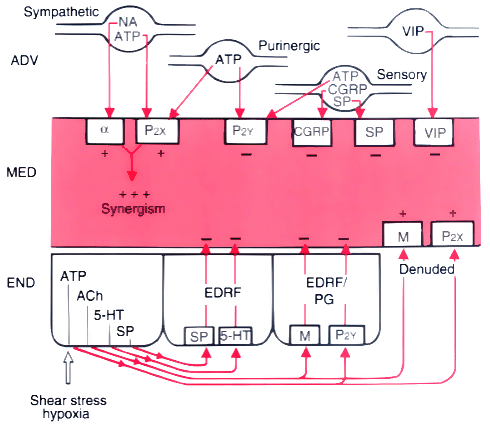 |
 |
Figure 16-8
Schematic representation of potential modes of regulation
of vascular tone by endothelial cell-related mechanisms. Norepinephrine (NA), adenosine
triphosphate (ATP), calcitonin gene-related peptide (CGRP), substance P (SP), and
vasoactive intestinal polypeptide (VIP) can be released from nerves in the adventitia
(ADV) to act on their respective receptors in the media (MED) to cause vasoconstriction
or vasodilation. ATP, acetylcholine (ACh), 5-hydroxytryptamine (5-HT), and SP released
from endothelial cells (END) by shear stress or hypoxia act on their receptors on
endothelial cells to cause release of endothelium-derived relaxing factors (EDRF)
or prostaglandins (PG), which act on smooth muscle to cause relaxation. In areas
denuded of endothelial cells, opposite effects may be produced by receptors on the
smooth muscle. α, noradrenaline receptor; M, muscarinic receptor; P2x
,
P2x
-purinoceptor; P2y
, P2y
-purinoceptor. (From
Lincoln J, Burnstock G: Neural-endothelial interactions in control of local blood
flow. In Warren J [ed]: The Endothelium: An Introduction
to Current Research. New York, Wiley-Liss, 1990, p 21.)

 |
